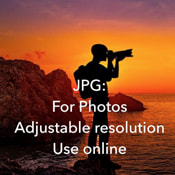Field Notes Blog
News and thoughts on UI/UX, web design, and more.

Welcome to Pixel Lava Digital Summer Camp!⛱️ Every week we’re diving into a new lesson designed to build your skills to rule the web! Whether you’re a small business owner, nonprofit pro or or want to build job skills, this is for you. In this one minute video episode you'll learn about the top most common file formats, their real names, what they are actually for and which ones to use where to get the best results. I'll cover everything from JPGs to EPS, including handy links to get more detailed information. To get a FREE, frosty new episode each week, join my mailing list.
JPG aka JPEG stands for Joint Photographers Experimental Group and it’s the file type developed to best display photos. It’s lossy compression method is adjustable from high to low resolution and it’s the workhorse of the web. https://en.wikipedia.org/wiki/JPEG
PNG stands for Portable Network Graphics and it’s the file type developed to best display images for the web. It was developed as a higher quality alternative to GIFs. PNGs are used most often for images where a transparent background is needed but beware, in the same image saved as a JPG and a PNG, the PNG will be larger in file size due to its lossless compression. https://en.wikipedia.org/wiki/Portable_Network_Graphics GIF (pronounced like Gift) stands for Graphical Interchange Format and it’s used for images on the web. Since its inception way back in 1987 through its animated resurgence today it’s been the best way to get images down to their smallest file size. https://en.wikipedia.org/wiki/GIF TIF stands for Tagged Image File Format and it’s the file type for print images, especially CMYK images used in print layouts. https://en.wikipedia.org/wiki/TIFF EPS stands for Encapsulated Post Script and it’s the file format for creating self-contained images and documents for print. It is mostly used by graphic artists. A layout can contain fonts and images so preparing it as an .EPS file ensures that when the printer opens it all of the parts are within it. https://en.wikipedia.org/wiki/Encapsulated_PostScript PDF stands for Portable Document File and it’s the format for creating self-contained documents to share with just about anybody. PDFs are used for everything from press releases to brochures to ebooks to real books. It’s a great way to share documents but beware, you can’t place a pdf on a web page and have it display like a photo. https://en.wikipedia.org/wiki/PDF What to use where?
That's it for this week. To get a FREE, frosty new episode for the next 8 weeks, join my mailing list.
0 Comments
Your comment will be posted after it is approved.
Leave a Reply. |
BlogAbout the authorAs the owner of Pixel Lava Interactive I've helped hundreds of small businesses and nonprofits with websites, graphic design and more. I hope you'll find this blog full of useful information.
~ Ame Stanko Categories
All
Archives
November 2023
|